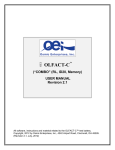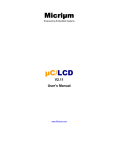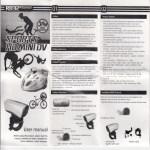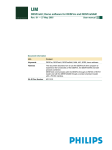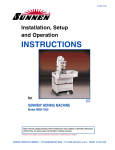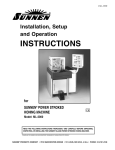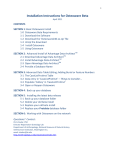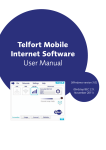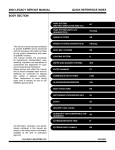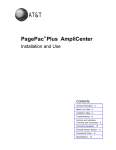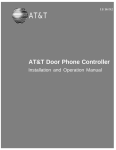Download Access control/crypto system
Transcript
US006351813B1 (12) United States Patent (10) Patent N0.: Mooney et al. (45) Date of Patent: (54) ACCESS CONTROL/CRYPTO SYSTEM . (75) - ~ Inventors. David ~ . EP J. . Klmllnger, MapleWood; James . 238g)“ Bradley> Plymouth an of MN _ Feb. 26, 2002 FOREIGN PATENT DOCUMENTS Mooney, Eden Prairie, Paul _ US 6,351,813 B1 0191162 A2 * 8/1986 ......... .. 4/1993 ~~~~~~~~~~~ n GOGFWOO * 9/1995 * 8/1997 ........... .. G06F/1/00 WO 93/06542 * W0 WO 95/24696 97/29416 _ G06F/12/14 OTHER PUBLICATIONS (73) Ass1gnee: Digital Privacy, Inc., Minneapolis, MN (Us) “The Smart Card: A high security tool in EDP” (R.C. Ferreira, Sep. 1989, Philips TDS Review, all).* (*) Notice: Subject to any disclaimer, the term of this patent is extended or adjusted under 35 * cited by examiner U.S.C. 154(b) by 0 days. Primary Examiner—Phung M. Chung (21) Appl. No.: 09/117,898 (22) Filed: Aug- 7’ 1998 Assistant Examiner—Paul E. Callahan (74) Attorney, Agent, or Ftrm—Fredr1kson & Byron, PA. (57) ABSTRACT Related US. Application Data _ (60) Provisional application NO_ 60/011,423’ ?led on Feb 9’ 1996, and provisional application No. 60/011,635, ?led on An access control/crypto system havmg a smart card reader and an access control program for requesting information Feb 14: 1996- from a user to determine if the user is authorized to access (51) Int. Cl.7 ................................................ .. H04L 9/00 the Computen The access control/crypto System usesfincryp' (52) US. Cl. ..................... .. 713/185- 713/171- 713/172- “on and Smart Card technology as a means for securlng ?les Stored On the System, ~teleC0l'Ill'Illll'llCajted globally, of (58) 380/283 archived to a chosen media. The system includes an access 713/165 166 hierarchy, combined With the issuance of smart cards, to 172 183’ 185? control the various levels of access provided by the system. Field of Search 713 ’ 38’0/259’ 266 269’ 283’ 275; ’ (56) ’ ’ ’ Further, the present system provides secure ?le transfer by encrypting sensitive ?les at a ?rst site, transferring the References Cited encrypted version to a second site, providing an authorized user at the second site With a secret passWord, and decrypt US. PATENT DOCUMENTS 5,191,611 A * 5,327,497 A * 5,479,512 A ing the ?le at the second site using the secret passWord under 3/1993 Lang ......................... .. 380/25 7/1994 Mooney et al. * 12/1995 control of the authorized user. 380/25 17 Claims, 12 Drawing Sheets Weiss ........................ .. 380/28 100 / 110,, 1204:‘ 170_» — [13 150 180-’ i f__ 130 4; SMART CARD l KEYBOARD READER U.S. Patent Feb. 26, 2002 Sheet 1 0f 12 US 6,351,813 B1 100 110“ 120v‘: / 170J_—_ua 150 180“ 13o 4U, SMART CARD I KEYBOARD FIG. 1 190 g : [|_-——1=1 My ‘\ x 1&0 READER U.S. Patent Feb. 26, 2002 Sheet 2 0f 12 BEGIN SESSION 210 POWER UP COMPUTER ~22O I ACTIVATE OPERATING ~23O SYSTEM I EXECUTE SOFTWARE ~24O I OPEN USER INTERFACE ~25O I EXIT PROGRAM DONE FIG. 2 ~26O 270 US 6,351,813 B1 U.S. Patent [ Feb. 26, 2002 BEGIN J~310 V EXECUTE SOFTWARE ~52‘) V CREATE OR SELECT US 6,351,813 B1 Sheet 3 0f 12 1 BEGIN I~39O V SELECT PROJECT ~395 V ~ 330 PRESS “START” ~397 KEY V V IDENTIFY SOURCE DONE ~34o F|LES(S) FIG. 3B II ENCRYPT/ DECRYPT ~35O V IDENTIFY DESTINATION ~36‘) V EXECUTE THE ENCRYPT/DECRYPT ~37O FUNCTION FOR ALL SOURCE FILES V [ DDNE FIG. 3A )580 I U.S. Patent Feb. 26, 2002 Sheet 4 0f 12 US 6,351,813 B1 410 _ SecureFEDS /l PROJECT: L ‘ KEY CURRENT KEYI M II] ALLOW AUTO KEY oETEcT SOURCE DIRECTORY: ld:\SRCE\APPS\APP1 FILE: d:\...\upps l2] INCLUDE ENTIRE DIRECTORY TREE @ ENCRYPT O DECRYPT O DIRECTORY: C:\ O OVERWRITE FILES o USER FED's FILE EXTENSIONS NEW DIRECTORY START @IPREsERvE FILE EXTENSIONQ CANCEL QUIT FIG. 4 FILES: 230 TIME: 0=25=45 CURRENT: MYFILE."XE U.S. Patent Feb. 26, 2002 —— Sheet 5 0f 12 US 6,351,813 B1 ELECTRONIC KEY CATALOGUE KEY SEARCH AND SEECTION SEARCH FOR: I |I START SEARCH l "NO SEARCH REQUESTED" IIENI E 510\ KEY ADMISNFTRASTION 52f) KEY NAME: COMKEY COM PORT: KEY SIZE: 21 BYTES SECURITY LEVEL: % EXPIRE OPTIONS: - GUEST OPTIONS: o NEVER 0 BY DATE // @ BY USER COUNT 1 MAKE NEw KEY com 530 I E] ALLOW GUEST To COPY E1 ALLow GUEST TO MODIFY l1 [ALLOW GUEST TO OFFLOAD] | DELETE THIS KEYv H SAVE CHANGES I T \ r540 USE THIS KEY I I J Tl 560 550 FIG. 5 CANCEL WINDOW U.S. Patent Feb. 26, 2002 Sheet 6 0f 12 US 6,351,813 B1 610 K\ ACCESS LOGIN SECURITY LEVEL: ILEVEL 2 \ 1) QUESTION: WEARS TRENCH COAT ‘El ) 620 630 / ACCESS CODE; Ituuuunnnl 0K STATUS FIG. 6 \ CANCEL 1 U.S. Patent Feb. 26, 2002 Sheet 7 0f 12 US 6,351,813 B1 710 | DIRECTORY: ¢\... GENERICDEF WINMAIN.C [bin] [doc] [Obi] [Pd] E INCLUDE ALL SUBDIRECTORIES OK CANCEL FIG. 7 U.S. Patent Feb. 26, 2002 Sheet 9 0f 12 SECURITY HIERACHIES LEVEL 0: CARD PIN LEVEL 1: ACCESS CODE 1 LEVEL 1 DATA LEVEL 2: ACCESS CODE LEVEL 2 DATA LEVEL 3: ACCESS CODE . LEVEL 3-5 FIG. 9 US 6,351,813 B1 U.S. Patent Feb. 26, 2002 Sheet 10 0f 12 US 6,351,813 B1 FIG. 10 1004 1002¢ CARDPIN 10506 RW: ACI ' SESSION KEY(8) = 100a CATKEYS(CARDPIN,SER#1) 1010 rrAl SIGNATURE 1016 LVLOCRYPTKEY= VERSION (2 CATKEYS(SESSKEY,ITA|SIG) e LEVEL 1 QUESTIONS (20xn) LEVEL 1 KEYS (8xn) /, 1014 DES(DTA,LVLOCRYP(KEY) ~ 1018(0) , LEVEL 0 / / \\ \ \ / I, I \ USERQUESTION1 1024(0) 1020(0) 10240)) USERQUESTION1 \ \ 1020(0)‘ 10 a .'\ 2 ‘L USERANS@ \ \ 10320 \ 10340)) \ \\ %ERAN$2 ( ) / l°28(b)‘.' 1032 b 10340 1 CATKEYS(ANS1,SER#) / / S ~DES(CANSSER1,LVL1 KEY1) \ 1 \CATKEYS(ANS2,SER#) ,1 / \\ / ~DES(CANSSER1,LVL1 KEY 1 1/ \ 10360\ \1040\/ 1044\ L / DES(CANSSER2,ACCCODE)<— LvL1 ACC 000L -~DES(CANSSER2,ACCCODE) L 1018(b)\ \ 1048\ LVL1 CRYPTKEY=CATKEYS(LVL1 DES(FILEDATA,LVL1CRYPTKEY) <>— LVLOCRYPTKEY 1052\ RW: ACI ACCCODE 1 1012(b)\ LEvEL KEY FILE (SEE ABOVE) NEXT 105m ‘054 LEVEL LvL1 APPL1 KEY = — ®> APPKEY CATKEY(LVL1 CRYPTKEY 1057 APP 1 DATA LEVEL LEVEL 2 L 105m RW: A} ‘059 DES(FILEDATA,LVL1APP1KEY == APPUCATION 1 FILE U.S. Patent Feb. 26, 2002 Sheet 11 0f 12 1120 F___i__j DATA I = I FAX I: | 1 : VIDEO -lL-> I MESSAGE I =' l- _ _ _ _ __ __ 1130 11810 I US 6,351,813 B1 r___i__? ENCRYPTION =I DATA’ ~DES S‘ FAX’ - RSA 1 - FORTEZZA I 1 -—-1~ ‘OTHER I VIDEO’ :_ =1 MESSAGE’ I _l I_ UNENCRYPTED KEY II _ _ _ _ _ ._ _l ENCRYPTED 1160~ “1140 II USER A I SMART ~1 150 E‘ CARD <23 a Q 2 (I) Z < (I |_ 1180 F___i__j I DATA % I FAX % I I : VIDEO JT‘ I MESSAGE l= L_. _ _ _ _ _ _ 11570 DECRYPTION ' 252 1165 r___i___l = I DATA’ I = I FAX’ I . I = ; ‘OTHER = I MESSAGE’ I VIDEO’ L. UNENCRYPTED _ _ _ _ .._ : _ _I ENCRYPTED KEY II ~1195 II USER B SMART E1190 5 CARD FIG. 1 1 K II: . FORTEZZA _J I U.S. Patent Feb. 26, 2002 F 8m9%QBO8O6, Sheet 12 0f 12 US 6,351,813 B1 4.i-L A |1 5mown8mPS 8E0 _ 0520$% EmiR8 “952? Em3mgm8mBm$3mRmSm@Nm w .. a. own ww NP.O_|._ US 6,351,813 B1 1 2 An alternate embodiment of the present system provides ACCESS CONTROL/CRYPTO SYSTEM secure ?le transfer by encrypting sensitive ?les at a ?rst site, According to 35 USC Section 119(e), this application claims the priority of US. Provisional Patent Application transferring the encrypted version to a second site, providing Serial No. 60/011,423, ?led Feb. 9, 1996 and US. Provi sional Patent Application Ser. No. 60/011,635 ?led Feb. 14, and decrypting the ?le at the second site using the secret passWord under control of the authoriZed user. This embodi ment provides secure transfer of information regardless of the transfer means used. In addition, the access hierarchy may be incorporated into this embodiment to provide vary ing levels of security for both the transmitter of information and the receiver of the information. In one embodiment, the systems at both the ?rst site and the second site are programmable to perform encryption or decryption, providing a secure bidirectional ?le transfer system Which may optionally use any mode of communi cation available Without risking loss or decryption of sen an authoriZed user at the second site With a secret passWord, 1996. FIELD OF THE INVENTION The present invention relates generally to a trusted secu 10 rity system and in particular to a system for protecting and controlling access to data using a system of electronic keys and a memory device. BACKGROUND OF THE INVENTION 15 There is an increasing number of computers in use in sitive information. In an alternate embodiment, a compres business today. These computers have a large amount of propriety information Which must be protected from unau thoriZed access. Additionally, secure transfer of sensitive information is a concern, since many forms of data transfer are susceptible to intrusion by computer hackers and other unauthoriZed persons. Data often has varying levels of security and associated With those security levels are the various classes of persons sion feature is incorporated prior to ?le encryption to 20 compress the data ?le, so that the encrypted version of the ?le is transferred more easily to the second site. The received ?le is decrypted and decompressed to provide the original ?le, provided the user at the second site has the appropriate secret passWord and the requisite access to the system via the 25 Who are authoriZed to access that data. A single passWord, smart card and card reader means. Other embodiments are described Which feature auto matic ?le handling, so that unencrypted ?les are removed therefore, is ineffective at adequately protecting sensitive and erased from the system during the encryption process to data. ensure that the sensitive information is not accidentally left on the system and vulnerable to unauthoriZed persons. After One system for preboot protection for a data security system is provided by PCT application WO 95/24696, by 30 Mooney et al., Which provides a secure computer controlling access to data storage devices via a card reader. Another system relates to protection of material on storage media and for transferring material on storage media to various recipi ents according to US. Pat. No. 5,191,611 to Gerald S. Lang. encryption, the encrypted ?les are accorded special eXten sions to identify the ?le as the encrypted version of the original ?le, and the original ?le is overWritten to render the original ?le unrecoverable. This means that the user must have the appropriate key to decrypt the encrypted ?le and 35 integrated compression and encryption (concryption) of data ensures security of the sensitive information. Another aspect of the present system is an access control/crypto system including communication means for providing proper com according to US. Pat. No. 5,479,512 to Kenneth P. Weiss. HoWever, none of these systems provides an access control/ crypto system including communications means for con cards. This aspect alloWs the system to automatically select appropriate communications for a particular of smart card Yet another system relates to a method and apparatus for the munications With a number of smart card readers and smart 40 reader and smart card. Further embodiments are discussed, hoWever, these are intended to illustrate the present system ducting appropriate communications betWeen a number of smart card readers and smart cards. Therefore, there is a need in the art for an access control/ crypto system Which has redundant security features and and not intended in a limiting or eXclusive sense. 45 BRIEF DESCRIPTION OF THE DRAWINGS having restricted access to a single user per access smart In the draWings, Where like numerals describe like com card. There is also a need for an access control/crypto system ponents throughout the several vieWs: Which protects information regardless of the means by FIG. 1 is a block diagram of one environment in Which the Which the information is transferred from the source to the destination. The system should provide secure information 50 transfer over common communications carriers, such as the FIG. 2 is a How diagram shoWing one embodiment of a Internet and World Wide Web. The system must also provide for controlled, secure decryption at the destination by only user session; authoriZed users. There is also a need for a sophisticated access hierarchy for such a system to accord varying levels of security to various classes of users. 55 FIG. 3A is a How diagram shoWing a session according to one embodiment of the present invention; FIG. 3B is an alternate option of the session shoWn in FIG. 3A; SUMMARY OF THE INVENTION An access control/crypto system having a smart card reader and an access control program for requesting infor present system may be used; 60 mation from a user to determine if the user is authoriZed to access the computer. The access control/crypto system uses encryption and smart card technology as a means for secur ing ?les stored on the system, telecommunicated globally or FIG. 4 is a snapshot of a Main Screen; FIG. 5 is a snapshot of an Electronic Key Screen; FIG. 6 is a snapshot of a PassWord Screen; FIG. 7 is a snapshot of a File Selection Screen; FIG. 8 is a block diagram shoWing the different levels of operation of one embodiment of a security access program; FIG. 9 is a block diagram shoWing various security levels archived to a chosen media. The system includes an access 65 and hierarchy; hierarchy, combined With the issuance of smart cards, to control the various levels of access provided by the system. embodiment of the present invention; FIG. 10 is a block diagram of the access module in one US 6,351,813 B1 4 3 retrieved by the application during the ?le encryption/ FIG. 11 is a block diagram showing one embodiment of decryption process. To access the smart card 160 hoWever, the present invention; and the user must enter the correct set of passWords into the FIG. 12 shoWs one example of a smart card access system. hierarchy according to an alternate embodiment of the During the encryption/decryption process, the user may present invention. select options (1) to compress the documents, and/or (2) to include a digital signature Which provides logical proof of DETAILED DESCRIPTION OF THE PREFERRED EMBODIMENTS In the following detailed description of the preferred Who encrypted the document and that the document has not been tampered With. 10 embodiment, references are made to the accompanying draWings Which form a part hereof, and in Which is shoWn knoWn to those skilled in the art. Auser session is begun by by Way of illustration speci?c embodiments in Which the invention may be practiced. These embodiments are described in suf?cient detail to enable those skilled in the art to practice the invention, and it is to be understood that other embodiments may be utiliZed and that structural changes poWering up computer 100 (step 220) and activating an operating system program (step 230) to manage the 15 user. In a Windows@ environment this step is performed by clicking on an icon representing the softWare, Where in a taken in a limiting sense, and the present invention is recited by the appended claims and equivalents thereof. DOS environment this step is performed by keying in the appropriate text string. Other operating systems may execute The present system is an access control/crypto system Which may be practiced in a variety of embodiments, including, but not limited to, data access security, computer the program in manners knoWn to those skilled in the art Without departing from the present invention. 25 different algorithms to use When performing the encryption or decryption steps. The user exits the program (step 260) When they have completed processing ?les. According to one embodiment, When the user exits the program the 35 system for future encryption and decryption purposes. The user begins by executing the softWare (step 320). The desktop computer); (2) communicated to another computer via point to point netWork, E-mail, Internet, World Wide user is then given the option of creating a neW key for encryption/decryption 330 or selecting a previously created Web, or other electronic communication method; or (3) archived to any media. The encrypted ?les can only be key from the smart card. In one embodiment, the user is next asked to identify: decrypted using the electronic key contained on the unique, personaliZed, ITAI prepared smart card. The electronic key a source ?le or a set of source ?les (step 340). 45 Whether to encrypt or decrypt those source ?les (step 350). Walk-through by Explanation the destination ?le and directory information (step 360). functions for the identi?ed ?le or ?les (this step is optional and is not shoWn in the ?gure). These functions include but are not limited to data compression and digital FIG. 1 shoWs a personal computer system 100, Which is one environment in Which the present invention may be practiced. The computer system 100 has a monitor 110, signatures. chassis 120, hard drive 180, ?oppy drive 170, input/output port 150, keyboard 130 and smart card reader 140. Also included is a smart card 160 Which contains access infor program terminates, While in another embodiment the pro gram is left to operate in the background of the computer The softWare program execution logic How of one embodiment of the present invention is shoWn in FIG. 3A. stolen (e.g., stored on a hard drive of a portable, laptop, or provides a means of duplicating and transporting ?les to other users Without compromising data security. In one embodiment, the softWare provides a series of WindoWs (step 250) to assist the user in creating an encrypted ?le from an unencrypted ?le or, alternatively, decrypting an encrypted ?le. The softWare also offers a variety of batch processing options and provides several decryption system. It restricts access to, and ensures trusted security of con?dential, proprietary, classi?ed, or other sensitive information contained in ?les in the computer system. After the system encrypts the ?les (makes the ?les unreadable to those Without the required decryption key), the ?les may be securely: (1) stored on the computer system Without compromising the data, even if the computer is resources of computer 100. One example of such an oper ating system is Microsoft’s WindoWs®. Other operating system programs may be used Without exceeding the present invention. The softWare is then executed (step 240) by the may be made Without departing from the present invention. The folloWing detailed description is, therefore, not to be trusted security, telecommunications security, and archival security. For purposes of illustration, the invention is described here in the context of a computer security appli cation. Several other embodiments, hoWever, are possible Without departing from the present invention. The computer security application is a ?le encryption/ An overvieW of a typical user session is shoWn in the How diagram of FIG. 2. Prior to the start of the user session the softWare is loaded onto computer 100 in a manner Well The encrypt and decrypt functions may then be carried out mation and application speci?c information. In one embodiment, input/output port 150 is an RS-232 port. In an alternate embodiment, port 150 is a PCMCIA port. Other on the source ?le(s) as indicated in step 370. After the selected encrypt or decrypt functions are performed, the user 55 may either go back to the beginning and create a neW key or select an existing key, or terminate the softWare program. types of input/output ports are possible Without departing from the present invention, and the examples given herein In one embodiment, a short-cut is provided by recording the steps shoWn in FIG. 3B and storing them in a ?le referred are intended to be demonstrative and not exclusive or to as a project ?le. limiting. Walk-through With WindoW Interface Diagrams One embodiment of the present softWare is demonstrated by the screens shoWn in FIGS. 4 through 7. In this example, In one embodiment, computer 100 executes a special security program Which encrypts and decrypts ?les stored on hard drive 180, ?oppy disk in drive 170, or other electronic a user encrypts a series of ?les With a neW key by storage devices. A special key generation function is executed to provide unique encryption keys based on a pseudo-random key generator prior to encrypting or decrypt ing ?les. These keys are stored on the smart card 160 and performing-the folloWing set of keystrokes and mouse 65 actions. Prior to a user receiving the system, a smart card prepa ration program is run by ITAI to (1) initialiZe the smart card US 6,351,813 B1 5 6 access codes, (2) create necessary smart card ?les including Which source ?les may be identi?ed is shoWn in FIG. 7. session key ?les, level ?les and data ?les, (3) initialize those ?les With level key data, default questions, and the session Other ?le selection mechanisms may be implemented With out departing from the scope of the invention. The selection mechanism must simply be able return a list of ?les (for example in a “linked list”) to the caller of the function. key as described beloW it the “Access Control Code Mecha nism” section, and (4) initialiZe the smart card database (SCDB) described beloW in the “Smart Card Database” section. Upon receiving the system, the user changes the default questions and ansWers to something only that person The softWare also provides user-selectable processing options Which affect the original ?le(s) and neW encrypted ?le(s) during encryption/decryption. These options include: (1) overWriting the original ?le(s) With the encrypted data; can ansWer. Upon execution of the softWare of one embodiment of the present invention, the main screen shoWn in FIG. 4 Would 10 (2) overWriting the original ?le(s) With random data and then deleting the original ?le(s); (3) deleting the original ?le(s), appear. Auser presses the key button 410 and obtains the key leaving an image Which can be “un-deleted”; or (4) leaving search and selection WindoW shoWn in FIG. 5. In this example, the user is creating a key named “comkey” 510 and the original ?le(s) unmodi?ed. The encryption ?le(s) can: Each key is assigned a security level 530 Which is a measure of the number of hierarchical steps required to be completed before the user can have access to the key. As described in more detail beloW, a key may have certain single directory. The neW ?le names may: (1) retain their original names; (2) be modi?ed such that a single character is replaced by a ‘A’ (i.e., “patent.doc” Would be modi?ed to “patent.Aoc”); or (3) be renamed to a number, thereby attributes associated With it. The user can select from a masking the original name. The neWly encrypted ?le(s) variety of attributes 540, including but not limited to key contain information to indicate the original directory path (1) overWrite the original ?le(s); (2) be placed in a directory it is located in a smart card Which is inserted into the smart 15 tree Which mirrors the source tree; or (3) be placed in a card reader on COM port 1 520. expiration dates. In one embodiment, the user may choose and ?lename along With information returned from the from several types of keys suitable for various public and common “stat” system call. private key encryption/decryption algorithms including (but not limited to) RSA, Elliptic Curve, DES, RC5, RC4, and 25 RC2. After entering all of the appropriate information, the “make neW key” button 550 is pressed and an encryption key (such as a DES key) is generated by the softWare. But, before the smart card can be accessed for storing this key (as Well as for retrieving it later), a series of questions must be ansWered correctly by the user. The questions and ansWers Were preprogrammed by the cards oWner and knoWn only to secure ?les stored on a computer system. In an alternate embodiment, the system provides secure transportation of by him or her. One can therefore presume that only a user authoriZed by the card’s oWner has access to the keys (and other smart card information). After the “make neW key” button 560 is pressed, the passWord screen shoWn in FIG. 6 appears and a series of questions 610 is presented to the user Which must be ansWered before access is granted to the In one embodiment, When an encryption takes place, the default operation is that the program attaches the special extension to the encrypted ?le and destroys the original, plain-text data ?le to preserve security of the contents of the original data ?le. Once the key, source ?le, and destination ?le options have been chosen, the user may push the “start” button to begin the encryption/decryption process. As stated before, in one embodiment, the system is used 35 ?les, as illustrated in FIG. 11. In FIG. 11, the system 1110 converts unencrypted source ?les 1120 into encrypted ?les 1130 using a key 1140 generated by inputs from a user A and a smart card 1150. As shoWn in FIG. 11, the converted ?les 1120 may be data, facsimile, video, or other messages, such as e-mail. The encrypted versions 1130 are denoted as data‘, requested security compartment. The number of questions facsimile‘, video‘, and message‘, respectively. The encrypted asked depends upon the security level selected by the user. ?les 1130 may be transported using any transmission means 1160, including but not limited to a modem link, the Internet, the World Wide Web, US. Mail, or courier (e.g., ?xed in The user is asked one question 610 for each level up to and including the level selected 620. For example, if the user selected level 2, they Would be asked to correctly ansWer tWo questions. At each level there are multiple questions, one of Which is randomly selected by the softWare to be presented for that level 620. 45 removable media such as a ?oppy disk). The ?les are received at a remote site in their same encrypted form 1165 and decrypted by system 1170 using key 1195, Which is identical to key 1140. Key 1195 is created by, and obtained from, User A Who also has a smart card 1190 for access to In one embodiment, after the user enters three incorrect system 1170. ansWers, that security level and all levels under that security level are locked out to prevent further access by the user. FIG. 11 shoWs only one direction of data conversion and Those skilled in the art Will recogniZe that the number of incorrect ansWers triggering a lock-out may be adjusted to ?oW. In practice, hoWever, systems 1170 and 1110 may be bi-directional in nature and therefore provide a bidirectional, comply With a given site’s security policy Without departing secure data transfer means. from the present invention. In the embodiment shoWn, after the proper number of correct ansWers have been successfully entered, control is Principal Components and Processes 55 pose of smart card preparation is to format the smart card and incorporate the initial smart card access codes. An access code is a ‘passWord’ Which is initially randomly returned to the screen shoWn in FIG. 5. The user then presses the “Use This Key” button 550. All key information is passed back to the main control module WindoW (FIG. 4) except the actual key itself. The actual key is retrieved via a separate electronic key module interface When the key is committed to be used—this prevents the key from being generated by ITAI and then changed by the end user. The access code protection scheme is a built-in feature of smart cards. The smart card operating system requires unintentionally expired in the event the user decides to select submission of the correct access code before granting access to the information contained Within the smart card. The a different key after exiting the “Electronic Key Catalogue” screen shoWn in FIG. 5. After selecting an electronic key, the user must identify a ?le or set of ?les. One example of a ?le selection means by ITAI Internal Card Preparation This section describes smart card preparation. The pur 65 present invention supports several types of smart cards, each With its oWn formatting requirements and access code meth odology. US 6,351,813 B1 7 8 User Personalization of Smart Card Part of the user installation process includes the person The program library interface of the Electronic Key Module may be accessed from the WindoW interface just alizing of the smart card. During personalization, the user described, or from an external application via the same changes the “card pin” as Well as the questions and ansWers function calls (using techniques common in the art). The program library takes the key information data and generates an encryption key. Depending on the type of key being Which are used to access the smart card. When a user starts the application, he or she Will be asked to key in a the “card pin”. This Will unlock the section of the smart card Which contains the questions and ansWers Which are required to unlock the ?rst security compartment. When that compartment is unlocked, information becomes avail able to access the questions and ansWers to the following created, the Electronic Key Module may use external cryp tographic apparatus to do the actual key creation (such as those found in cryptography packages commonly available 10 security level. This process continues until the requested security level has been reached. Personalization of the smart card includes the process of getting questions and ansWers from the user and Writing 15 in the industry). In some embodiments, hoWever, the Elec tronic Key Module may create the key using internal algo rithms Without departing from the scope of the present invention. With the electronic key created, the module stores the key and the pertinent user information in the Smart Card Data base (using the SCDB module). The resulting status of the database transaction is the embodiment of the caller being them to the smart card in a secure format. Depending on the application, the user Will be alloWed, through maintenance functions, to change both the “card pin” and all questions the WindoW interface, the status information is displayed to and ansWers during future sessions. the user using common text controls. Keys The present softWare is useful to protect data from theft. What is an Electronic Key? It utilizes features of the smart card to authenticate users While incorporating multiple levels of security. Once An electronic key is a piece of digital information used to control access to system resources such as data ?les, pro authenticated, the user is granted access to a database Which gram modules, or peripheral devices. The digital informa tion is formulated such that the key cannot be guessed or otherWise recreated Without permission of the key oWner. stores objects such as electronic keys. One of the unique Access to any protected resource can then be controlled features of this invention is the fact that electronic keys to a variety of resources may be stored on the smart card. For example, a user may store an electronic key Which accesses according to Who has control of the electronic key. In one embodiment of the present invention, electronic keys are card Which is used to store keys that control access to 25 an electronically controlled-door lock on the same smart electronic mail. In the case of a door lock, the key provides stored on the smart card in such a fashion that only the intended user is alloWed access to these keys. Any attempt by unauthorized users to access the electronic keys on the the correct digital signature to activate the locking mecha nism. In the case of ?le encryption, the key is the initial seed smart card results in the logical destruction of these keys (thereby maintaining the integrity of the resource protected by the keys). for an encryption engine such as DES. The actual device or mechanism controlled by these keys is not restricted by this 35 In one embodiment, the softWare alloWs a user to create, modify, store, access and delete a universal electronic key set using a smart card. These electronic keys are used to encrypt and decrypt electronic information including, but not limited to, E-mail, data ?les and data communications. In other embodiments and applications, electronic keys are invention. According to one embodiment, information other than electronic keys is secured on the smart card. Access to the secured information is protected and controlled in the same fashion as described for protecting electronic keys. In one embodiment, there are tWo types of keys, auto used to restrict access to electronically controlled devices matic keys and manual keys. Automatic keys are comprised of a random number generated by the application and including, but not limited to, electronically controlled door locks and automobile ignition systems. primarily used for exporting and importing automatic keys. Creating Keys manual keys are made up by the user. Manual keys are 45 by the Electronic Key Module. The module presents tWo interfaces for creating keys, a WindoW (GUI) interface, and In a preferred embodiment, a user instructs the present invention via a graphical user interface (GUI) to create keys and store them on the smart card. There are several pieces of a program library interface. The WindoW interface presents the user With buttons, edit WindoWs and other controls Which alloW for the collection of data from the user. The data collected includes all informa tion required to construct the keys as previously described. This information includes, but is not limited to, the encryp tion algorithm for Which the key Will be used, the human readable name associated With the key, and the key attributes. The WindoW controls themselves are not unlike those used on most personal computers. They may be designed using common softWare development tools. It is the responsibility of this module to: (1) perform all functions necessary to display and control the mouse, keyboard and screen for the given operating system environment; (2) Automatic keys are the keys Which are used to do the actual data encryption. Key administration, including key creation, is controlled 55 information Which get created and stored With each key, including a unique key ID, a human readable name given by the user, and several key attributes. The key itself is actually generated by algorithms run on a computer or by external hardWare encryption devices attached to the computer. The algorithms vary according to the encryption method Which Was chosen. The key name is the English name the user Wishes to associate With an actual key and is associated With the key at the time it is created. When the user does the data encryption the key is selected according to the associated English key name. retrieve information from the user pertaining to the elec Key attributes are a means of providing security options to the user. They de?ne such things as the life-span and tronic key being generated via keyboard and mouse; (3) security levels of the keys. For example, some keys may be organize user data in a format suitable for use by the 65 one-time use keys Where the key is destroyed after a single Electronic Key Module’s key creation functions; and (4) display status information. encryption. Listed beloW are options provided by one embodiment of the present invention: US 6,351,813 B1 9 10 Fixed Count Use Keys: A?xed count use attribute allows a key to be used only a speci?ed number of times. Each time including proprietary encryption methods, Without departing from the present invention. Other Attributes: Other attribute types may be added Without departing from the present invention. In the embodiment shoWn, the electronic keys are stored the key is referenced the count drops by one. Once the count reaches Zero the key is deleted and can never be referenced again. Duplicable Keys: Setting the attribute to alloW duplication on a smart card Which is accessed via a smart card reader permits a “guest” (a guest is a user other than the key oWner) device connected to a personal computer. One skilled in the to copy the key to other users. This attribute is used in cases art Will, hoWever, readily recogniZe that any device that can Where the guest is trusted, generally loW security situations read or Write smart cards may be used to access the smart such as Work groups sharing access to semi-critical infor mation. Expiry Date: This attribute destroys a key once a certain date is reached. This attribute assumes that the system date is secure, such that a guest cannot manipulate the system date and bypass this mechanism (this is not generally a safe 10 card instead of a personal computer. Duplicating Keys Once a key is created and stored on the smart card, it may be copied (at the discretion of the key oWner) to a second smart card, or sent to a remote user Who doWnloads that key 15 assumption in the case of personal computers). Fixed FloW: The Fixed FloW attribute controls the number onto his or her oWn smart card. This feature permits multiple smart cards to hold identical copies of the same key and thus access the same device or exchange encrypted ?les over an of accesses granted to a particular user in a given time frame. This controls the number of times a user is granted access to an object or ?le. If the key Was used, for example, to open unsecured netWork in a secure manner. a door, then the user could be limited to passing through the Electronic keys may be copied to other users, referred to as “guests”. The mechanisms to copy electronic keys to guests create an encrypted sequence of data that can be door n-times per day. stored as a ?le on any common data storage device (such as Group Keys: The Group Keys attribute provides classi ?oppy or hard disks) or transferred via electronic mail, ?cation of groups of users and sorts the classi?cations modem, or any other medium used to transfer common data according to access level. In one embodiment, the system 25 ?les. The user Who created the key (the key oWner) attaches provides for a common key identi?cation for more than one attributes to the keys Which are contained as part of the user. The common key provides access to sensitive ?les for electronic key data. The key attributes provide means to: (1) all users contained in that group. Each user may also have expire keys, preventing them from further use based on (a) other keys at varying levels of security, the number of keys limited only by the memory capacity of the smart card. Ultra Secure: This feature provides a second passWord elapsed time measured in days, (b) number of uses and/or rate of usage per hour or day; (2) prevent or alloW keys to be further duplicated by guests; (3) alloW or disalloW features for saving keys on-disk; (4) alloW or disalloW features to automatically detect Which key to use during the query, requiring the user to enter a second passWord or other biometric information. The additional information is used to generate the encryption key used to encrypt the ?le. This provides a second layer of security, since both keys are used to encrypt the ?le. Auto Key Detection: Auto key detect provides conve decryption process; or (5) automatically change the keys 35 over time (these are referred to as dynamic keys). There are three Ways for keys to be destroyed: The ?rst Way is via smart card destruction. Smart card destruction nience to the user. Rather than having to select the key to occurs When an unauthoriZed user exceeds the limit for decrypt a ?le, the system automatically detects Which key invalid access code submissions. In this case, the smart card needs to be used, after the user has submitted the access code automatically and permanently locks up. Once the smart to the smart card. This slightly reduces the level of security, since this information Will need to be semi-public informa card is locked, there is no Way for anyone to access the cards tion in the object you are trying to access. Off-Load Permission: Lack of this attribute prevents a guest from off-loading this key from the smart card to an external storage medium such as a hard disk. If this permis sion is granted, then the user can free up space on the smart 45 deliberately locked out during smart card preparation. The second Way to destroy a key is via manual key card by storing keys on a hard disk (With encryption pro tection of course) and reloading them to the smart card only When needed. Periodic Keys: Certain applications can deletion. Manual key deletion refers to the user activating the graphical user interface (GUI) providing WindoW con trols to select a key from a list of keys currently stored on the smart card, and selecting a button Which initiates a function Which removes the selected key from the smart card. modify keys With use. To make this Work, a neW key is created periodically and replaces the original key once it has been determined that all outstanding copies have been updated. Every oWner-to-guest transaction Would contain instructions to update the neW key Which Would result in or the keys therein. Under certain smart card con?gurations, the user may have the ability to unlock the smart card providing the Administrator access code has not been locked. The administrator access code can be locked by three unsuccessful submissions of that code, or it may be 55 The ?nal Way for keys to be destroyed is by automatic key decrementing a reference count. When the count reaches expiration. This occurs When one of the automatic destruc Zero, the original key is no longer needed and is removed from the smart card. Only certain types of application are tion key attributes is selected during key creation or expor tation. For example, a key can be con?gured to expire on a given day or after a certain number of uses. The key is then automatically invalidated and deleted When that date or prede?ned number of uses is reached. able to make effective use of this feature. The characteristics of such an application include a loW number of guests and/or a high transaction rate involving tWo-Way correspondence Key Duplication/Key Sharing betWeen the oWner and the individual guests. Encryption Method: This attribute provides a means for indicating Which one of various encryption algorithms is to be used for encryption and decryption. Some examples of possible encryption algorithms are DES, RSA, and FORTEZZA. Other encryption algorithms are possible, In most cases, the users Will Want to share data With another remote user in a secure manner, requiring the 65 sharing of keys. Generally speaking, the key oWner creates a key and then makes a copy of that key for use by the remote user. The oWner of the key is said to export the key US 6,351,813 B1 11 12 While the guest is said to import the key. The system of the invention provides several means of accomplishing key duplication and transfer. In one embodiment, hoWever, the hoWever, that other interfaces or operating systems can be used Without departing from the present invention. In the preferred embodiment, the program library interface is Writ system assumes that there is one key oWner and that the key ten in the computer language C and/or C++. oWner has created a key Which is resident on his or her smart Module Descriptions card. One method of transfer is the direct key transfer method. This method Works by having the oWner insert his or her smart card into the smart card reader attached to the PC Main Control Module The main control interface 810 provides a starting point for the program knoWn in WindoWs programming as Win main. It is responsible for retrieving and dispatching mes sages from the operating system. The main control interface 810 is also responsible for collecting information from the other modules and sending that information to the File Encryption/Decryption Module 820 Where it is used to control the processing of the ?les to be encrypted or running the application and requesting a direct key transfer of a speci?ed key. The selected key is extracted from the smart card and stored in the memory of the PC. The guest then inserts his or her smart card into the same machine, enters the security access code, and ansWers his or her questions. The key then gets copied from the PC’s memory 15 decrypted. The main control interface 810 is also responsible for the onto the guest’s smart card. The second method of transfer is the remote key transfer method. This method Works by using manual keys. First the main WindoW display. The main WindoW display provides buttons, edit WindoWs, check boxes, scroll bars, et cetera, oWner selects the remote key transfer option and selects a key. The key oWner is then asked to enter a question and ansWer set Which Will be presented to the guest. The ansWer is converted into an encryption key Which is used by an collectively knoWn as WindoW controls, Which are not unlike those found in other WindoWs programs. The WindoW con trols in the main module 810 provide the user With access to the to the other WindoW and program library interfaces. encryption algorithm to encrypt the real key to be exported. The key to be exported is then encrypted With this neW key File Encryption/Decryption Module and the encrypted information is Written to a ?le. This ?le can then be transmitted via netWork, the Internet, the World Wide Web, or exported to diskette or other removable media and sent via US. Mail or courier, Without This interface 820 de?nes a library of function calls and 25 data structures Which take as input a de?ned set of source ?les, an electronic key, and a de?ned location for the resultant encrypted ?les. The library function 822 then encrypts the source ?les using DES 823, although other encryption algorithms may be used. For example, in alter compromising security. The remote user must acquire the manual key from the oWner separately via telephone, fax, courier, etc. The guest then selects the import key option and is presented With the question Which the oWner supplied. nate embodiments the system incorporates a commercial encryption algorithm, government encryption algorithms, or both. This provides an encryption Which is compatible for The ansWer given by the guest is converted into an encryp either commercial or government uses, or can be con?gured to handle both. Various options are available based on tion key used to decrypt the exported key With algorithms similar to those used on the oWner’s side. 35 Regardless of the method of key transfer, once both users arguments supplied to the interface, the original ?les may be overWritten or mirrored in a separate tree. When mirrored ?les are used, the original ?les may, if have shared a key, data can be encrypted and shared over any digital communication channels or left on a disk drive and requested, be overWritten to destroy the original data and then automatically deleted. To alloW the key to be automati cally selected during the decryption phase the ?les may still be secure. Library Modules OvervieW The program contains the folloWing interfaces or modules include information to identify the key, but do not contain (shoWn in FIG. 8), Which provide access to module layers: (1) Main control 810 attribute. File Selection Module This interface 831 de?nes structures and provides WindoW controls for the user to broWse ?le systems and de?ne sets of ?les. This list of ?les is passed back to the main module (2) File Encryption/Decryption 820 the key itself. This pertains to the auto-key-detect key 45 (3) File Selection 830 (4) Electronic Key 840 810 and ultimately used by the File Encryption/Decryption (5) Smart Card Data Base (SCDB) 850 (6) Smart Card Access 860 module 820. Electronic Key Module (7) Smart Card Operations (SMOPS) 870 (8) Card Reader Operations (CROPS) 880 (9) COM (device layer) 890 This interface 841 provides WindoW controls to access the electronic key database 852 stored on the smart card. The program library 842 in turn accesses the smart card database interfaces 851. The purpose of this module 850 is to take For the purposes of this document, ‘interface’, ‘layer’ and ‘module’ are used interchangeably. SMOPS 870, CROPS 880, and COM 890 are collectively referred to as the loWer layers. The SMOP’s interface 870 therefore may be referred 55 modify keys, (c) delete keys, (d) de?ne key attributes, and (e) broWse the electronic key database. Any selected keys are passed back to the main module 810 and ultimately used to as the loWer layers. by the File Encryption/Decryption module 820. Each interface may be classi?ed into one or a combination of the folloWing interface types: a WindoW interface, also referred to as the end-user interface, and a (program) library interface Which is called by other programs or program libraries. In one embodiment, the program library 842 is interfaced by the electronic key WindoW interfaces 841. In alternate embodiments, hoWever, other programs or modules directly access the electronic key program library 842. In one embodiment, the WindoW interface utiliZes the programming interfaces supplied by Borland Turbo C® and Borland Resource Workshop® to run on any version of Microsoft WindoWs®. One skilled in the art Will recogniZe, user input via WindoW controls to: (a) create keys, (b) 65 Smart Card Database Module This database module 850 provides a programming inter face Which alloWs the user to store a collection of objects called records into a database. A record in a block of US 6,351,813 B1 14 13 COM (device layer) Module information broken into one or more ?elds. A database This module 890 is responsible for handling the PC I/O makes it possible for the user to search for, add, delete and update information contained in one or more records. mechanisms. In one embodiment, communication is pro The functionality of the Smart Card Database Module programming interface 850 and module body is similar to that of database application programming interfaces com monly found in the industry. One distinguishing feature is vided via UART COM ports. In alternate embodiments, hoWever, any type of input/output ports may be used Without that the Smart Card Database Module 850 utiliZes the Smart Card Access Module described beloW to provide informa tion storage With access protection. Smart Card Access Module departing from the present invention. Smart Card Description One example of a smart card is a GemPlus smart card (COS or MCOS, 8k With DES products) Which is compatible 10 thereof. One skilled in the art Will readily recogniZe that This module 860 has three responsibilities: (1) provide security above and beyond that already supplied by the other brands of smart cards Which conform to these stan dards and provide secure data storage functions may be smart card; (2) provide an interface to the smart card having the functions open, close, seek, read, Write, and ioctl; and (3) control Writes to disk ?les so that only the smart card Which 15 substituted Without departing from the present invention. Detailed Description of the Smart Card Access Module Within this section an “application” is de?ned to include any softWare Which directly calls functions available in the Smart Card Access Module. The Smart Card Access Module provides tWo distinct Was used to create the ?le can access the ?le. The disk essentially becomes an extension of the smart card. This feature provides a means to back up smart cards onto disk media in a secure manner, hoWever, it is certainly not limited to this usage. interfaces, the Security interface and the Logical File inter face. The application or human user, collectively referred to as “the caller”, may communicate to sub-modules either by Way of the WindoW interface (for the human caller), or Smart Card Operations (SMOPS) This module 870 provides one C language function pointer for each command in a prede?ned-smart card com mand set. It is responsible for manipulating the C function arguments to create a packet of data Which is issued to the Card Reader Operations layer to be submitted to the smart card. The module is designed in such a Way as to be smart With ISO 7816 standards and/or 10536 or derivatives through the exported C language library functions. Some 25 card independent. For example, the function Which turns the smart card on turns on any ISO compliant smart card (for example, Microcard and GemPlus smart cards). Other func tions include commands to read the smart card, create ?les sub-modules provide both a human interface and program ming interface functions, but most provide either one or the other. The sub-functions Which make up the body of the module provide the caller With controlled access to data stored the smart card. The body of the module sends requests to the SMOPS module in order to communicate With the smart on the smart card, submit access codes to the smart card, et cetera. card (the SMOPS module is described in other parts of this The preferred embodiment supports four types of smart cards: GemPlus COS, GemPlus MCOS, Microcard TB-100, The Security Interface document). 35 The security interface provides controlled access to the and Microcard TB-1000. HoWever other smart cards could smart card. It is responsible for retrieving questions and be incorporated Without departing from the present inven ansWers from the card, calculating and submitting access codes to the card, and calculating encryption keys Which are supplied to the Logical File interface. These keys are used to encrypt the information stored Within logical ?les on the tion. This module 870 makes the idiosyncrasies of particular smart cards transparent to the user. There are many suitable smart card. Ways to design this module Without departing from the present invention. One Way is through the use of C++ virtual The interface includes WindoW controls to present the questions to the user, retrieve the user’s ansWers, and change functions. A second Way is through the use of a function callout table. Generally speaking, there is a sub-module 872 for each supported smart card Which performs instructions to provide the behavior of the prede?ned command set. The speci?c code incorporated into the module depends 870 on the chosen smart card(s). 45 the questions and ansWers. There is also a set of function calls to retrieve the questions from the smart card and to submit requests. This input is used to calculate and submit the access codes Which are presented to the smart card and to calculate the encryption keys used by the Logical File Card Reader Operations (CROPS) interface. This module 880 is responsible for taking data packets from the SMOPS layer 870, appending headers and trailers one of tWo possible Access Hierarchies, Smart Card Access according to the smart card reader’s speci?cations, and then issuing the command to the smart card via the COM, PCMCIA, or other interface. The interface to the layer above is independent of the smart card reader (eg the same functions are used regardless of type of smart card reader attached to the system). One embodiment of the security interface incorporates Hierarchy and Access Control Mechanisms, described beloW. 55 program library interface similar to the standard C interface used to access disk ?les Which includes the function calls open, seek, Write, read, close and ioctl. The functions provided by this interface behave identically to the C disk ?le interface counter-parts With the folloWing exceptions: In one embodiment, three types of smart card readers are supported: the GemPlus GCR 200, the GemPlus GPR 400, and the Microcard TLP line. Other smart card readers may be added or substituted Without departing from the present invention. This module 880 has a prede?ned command set Which is incorporated using methods similar to those found in the SMOPS layer 870 Whereby there is one sub-module 882 for each type of card reader. These sub-modules 882 are respon sible for providing the pre-de?ned command set behavior. The Logical File Interface The Logical File interface presents the application With a The functions have a different name so as to be distin guished by the compiler and linker. The “open” function call takes as arguments a DOS style, ‘\’ delineated path name Where the ?rst segment indi 65 cates the COM port (“COM1”, “COM2”, etc.), the second segment is the security level (“1”, “2”, etc), and the third argument is a logical ?le number preceded by























